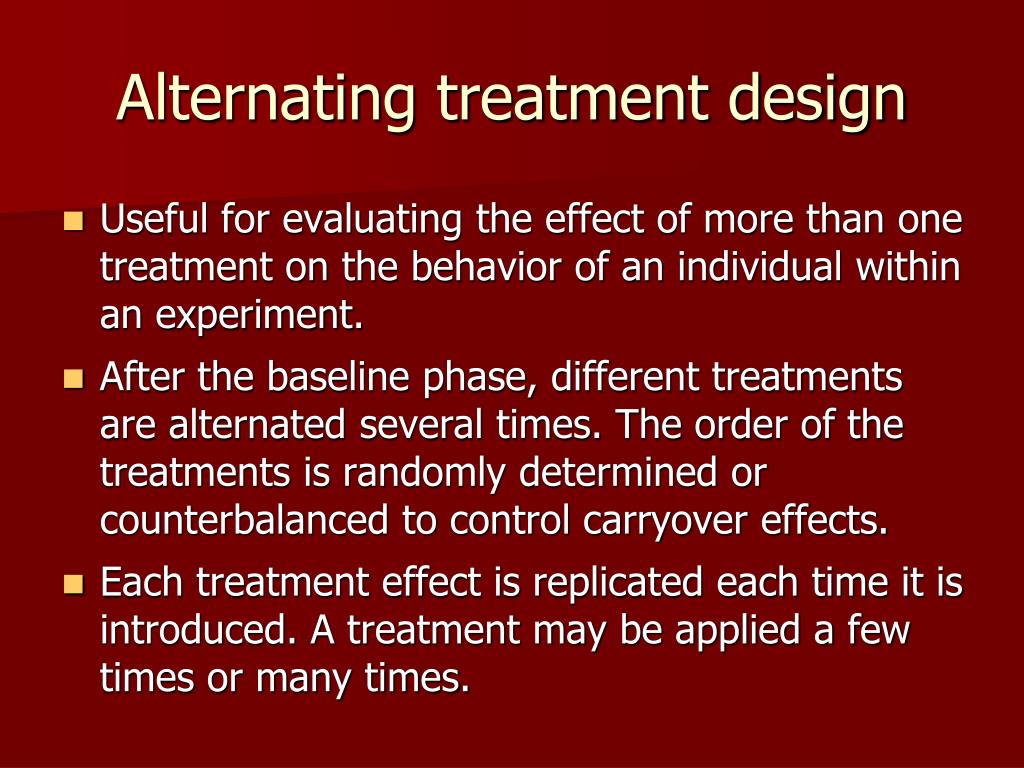Table Of Content

Then a treatment such as positive attention might be introduced first at school and later at home. Again, if the dependent variable changes after the treatment is introduced in each setting, then this gives the researcher confidence that the treatment is, in fact, responsible for the change. The percentage of time he spent studying (the dependent variable) was low during the first baseline phase, increased during the first treatment phase until it leveled off, decreased during the second baseline phase, and again increased during the second treatment phase.
Nonparametric statistical tests for single-case systematic and randomized ABAB…AB and alternating treatment ... - ScienceDirect.com
Nonparametric statistical tests for single-case systematic and randomized ABAB…AB and alternating treatment ....
Posted: Wed, 27 Dec 2017 00:58:04 GMT [source]
Multiple-Treatment Designs
The study was approved by the Institutional Review Board of the City University of New York (CUNY). The plotting of individual participants’ data, examining the data, and making judgements about whether and to what extent the independent variable had an effect on the dependent variable. The issue of when, if ever, the data generated from SSEDs should be statistically analyzed has a long and, at times, contentious history (Iwata, Neef, Wacker, Mace, & Vollmer, 2000).
Hair Dresser's Salon Talstrasse Zürich / Wülser Bechtel Architekten
As an additional strength, although their use requires random ordering of conditions for each participant, randomization tests are free from the assumptions of random sampling of participants from a population, normality or independence of the data (Dugard et al., 2012; Edgington & Onghena, 2007). This is important, because in the SCED context it cannot be assumed that either the individual or their behavior were sampled at random. Moreover, the data are autocorrelated and not necessarily normally distributed (Pustejovsky et al., 2019; Shadish & Sullivan, 2011; Solomon, 2014). Finally, when using a randomization test, missing data can be handled effectively in a straightforward way by randomizing a missing-data marker, as if it were just another observed value, when obtaining the value of the test statistic for all possible random assignments (De et al., 2020).
A Simulation Study on Two Analytical Techniques for Alternating Treatments Designs
For some Sweeten contractors, one million is considered low for condo work, and the HOA sometimes asks to be additionally insured. Informed consent was obtained from the caretakers of all the participants included in the study. With Alternating Treatment Design in ABA, you can efficiently evaluate treatments and find the most effective approaches for your child’s learning and development. Alternating Treatment Design in ABA is a therapy method that helps kids with special needs learn new skills.
Figure Figure44 depicts the data for the comparison of prompt-fading procedures with Sean. Maintenance sessions were conducted, with accuracy ranging from 70 to 100 % correct responding. Sean did not master targets assigned to the LTM training procedure in 42 sessions, and his performance was between 30 and 50 % correct prior to terminating this prompt-fading procedure. During the prompt hierarchy comparison, Sean’s responding in the control condition was variable, with scores ranging from 0 to 50 % correct. Of the aforementioned studies, Libby et al. (2008) conducted the most systematic analysis and comparison of MTL and LTM procedures. In the first experiment, a direct comparison of the procedures revealed that three of five participants met a mastery criterion with both procedures, whereas the other two participants only met a mastery criterion with the MTL procedure.
Interventionist
Meanwhile, single data collection sessions would be conducted in each of the other conditions to assess pre-intervention levels. Once responding has reached the criterion threshold in the intervention phase of the first leg, continuous measurement of pre-intervention levels is introduced in the second. When stable responding during the intervention phase is observed, intermittent probes can be implemented to demonstrate continued performance, and intervention is introduced in the second leg. This pattern is repeated until the effects of the intervention have been demonstrated across all the conditions. A randomization test is not to be applied arbitrarily (Gigerenzer, 2004), nor is it free of interpretation from the researcher (see Perone, 1999).
Within-subjects designs: To use or not to use?
2Given the absence of phases, immediacy and variability are likely to have a different meaning in the ATD context, as compared to multiple-baseline and ABAB designs. Regarding immediacy, an effect should be immediately visible, if it is to be detected, as each condition lasts for only one or two consecutive measurement occasions. Regarding data variability in each condition, it refers to measurements that are not adjacent.
Abstract
But it could also mean that the positive attention was not really the cause of the increased studying in the first place. Perhaps something else happened at about the same time as the treatment—for example, the student’s parents might have started rewarding him for good grades. In an alternating treatments design, two or more treatments are alternated relatively quickly on a regular schedule. For example, positive attention for studying could be used one day and mild punishment for not studying the next, and so on. The alternating treatments design can be a quick and effective way of comparing treatments, but only when the treatments are fast acting.
The interested reader is referred to regression-based procedures for model-based inference (Onghena, 2020). In particular, these techniques allow modeling the average level of the measurements in each condition and, if desired, the trends. The readings suggested for regression-based options in the SCED context are Moeyaert et al. (2014), Shadish et al. (2013), and Solmi et al. (2014), whereas for options in the context of N-of-1 trials Krone et al. (2020) and Zucker et al. (2010) can be consulted. Among the possibilities for a random determination for condition ordering, a completely randomized design (Onghena & Edgington, 2005) entails that the conditions are randomly alternated without any restriction, but this could lead to problematic sequences such as AAAAABBBBB or AAABBBBBAA.
An internal project, such as a minimal bathroom or kitchen renovation, might avoid those requirements, but “Title 24 is going to pop up on a lot of projects,” said Jordan. Sweeten has found that the cost of a retrofit for a 2,000-square-foot house will likely come in between $10,000 and $15,000. Whether there is any damage or rot to the existing framing as well as the cost of materials and labor will impact that figure, according to Sweeten. Those performing the soil report are looking for how firm the soil is or if there is bedrock, especially when building on a hillside. The results will determine how much work is needed to “get out of the ground,” meaning what is needed to support a secure foundation, he said. If you’re adding a new room, a second story, or a retaining wall or if you are on a hillside, you will most certainly need this.

The mastery criterion was 90 % or more correct independent responding for two consecutive sessions. After having met the mastery criterion with one prompt-fading procedure, additional sessions were conducted with the remaining two conditions. The number of additional sessions was set at 20 % of the total sessions needed to reach a criterion for the first prompt-fading procedure. For example, if the participant mastered the set of stimuli assigned to the MTL condition in 100 sessions, 20 additional sessions were conducted with the other two conditions (i.e., LTM procedure and control).
These designs provide strong internal validity evidence regarding the effectiveness of the interventions. External validity, however, may be compromised by the threat of multiple-treatment interference. Additionally, the same advantages and disadvantages of ABAB designs apply, including issues related to the reversibility of the target behavior. Despite their limitations, these designs can provide strong empirical data upon which to base decisions regarding the selection of treatments for an individual client.
Once responding is stable in the intervention phase in the first leg, the intervention is introduced in the next leg, and this continues until the AB sequence is complete in all the legs. A recent example of the withdrawal design was executed by Tincani, Crozier, and Alazetta (2006). They implemented an ABAB design to demonstrate the effects of positive reinforcement for vocalizations within a Picture Exchange Communication System (PECS) intervention with school-age children with autism (see Figure 3). A visual analysis of the results reveals large, immediate changes in percentage of vocal approximations emitted by the student each time the independent variable is manipulated, and there are no overlapping data between the baseline and intervention phases.
The test statistic is usually the mean difference actually obtained, due to its frequent use as a summary measure in ATD (Manolov & Onghena, 2018). Any aspect of the observed data (e.g., level, trend, overlap2) or any effect size or quantification (e.g., ALIV; Manolov, 2019) can be used as a test statistic. To conduct the analysis, the test statistic is computed for the actual (obtained) alternation sequence (for instance, ABBAAB). In particular, the measurements obtained (e.g., 6, 8, 9, 7, 5, 7) maintain their order as they cannot be placed elsewhere due to the likely presence of autocorrelation in the data (Shadish & Sullivan, 2011).

No comments:
Post a Comment